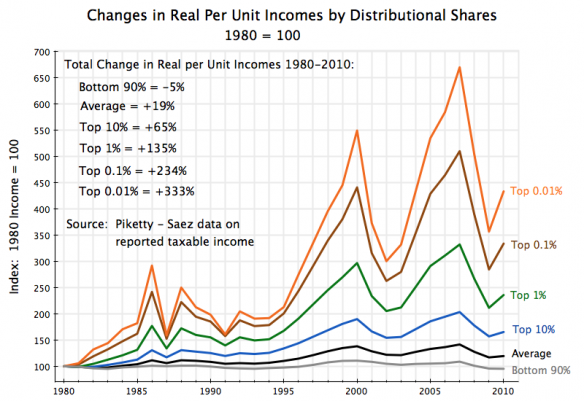Reagan-era tax breaks for the wealthy, which were instituted in 1980 and have become the norm for Republican presidents to continue since then, have resulted in the following financial effect on American households, as detailed in an article on An Economic Sense blog
IN YEAR 2010
• Income for the bottom 90% of households is -5% lower than 1980 levels
• Income for the bottom 9% of households is 35% higher than 1980 levels (those with incomes between the 90th and 99th percentiles)
• Income for the top 1% of households is 333% higher than 1980 levels
• The rate of growth for the US Gross Domestic Product (GDP) has remained steady at 1.9% since 1880
The consistent growth rate of the GDP at 1.9% means that households would need to have experienced an average of 76% growth during the 30 year period from 1980 to 2010 in order to keep pace with the expansion of the economy. But actually, even the income in average households failed to keep pace with even half that rate that rate of growth.
I am aware that a growing economic middle class in the United States, has meant more people creating wealth for the upper economic classes by investing in the companies they own, providing income to Big Money through banking money in their financial institutions which money is lent out at interest; and the negotiation of financial instruments in which either a purchase or a sale benefits the broker; the middle class has purchase insurance at ascending rates from financial institutions owned by the super rich; has given up using cash in favor of using credit and bank cards – which create revenue for financial institutions on every transaction. The middle class has increased the number of homes they own and consequently, the amount of money they pay on interest. And, they work for companies owned by Big Money and give of their time and talents to help their employees find more ways to save money, make money and invest wisely: which basically means, to the detriment of competitors, which in the event means all the people who are not members of the Big $ conglomerate.
It’s woefully easy to see why the growth of the middle class economic group has meant not that members of this group, themselves, become wealthier, but that the wealth of the people and companies providing services to them have grown exponentially in tandem with the middle class’ existence. The middle class think of themselves as fortunate for having the protection of their economic superiors, but they are not fortunate. Over time, their fortunes are in fact declining in relationship to the economy while their employers and service providers’ income soar. This means that the income levels of the bottom 9% will edge members of this group increasingly closer to the levels of the lower 90% and then we will have a true 99% v. 1% polarity of poor to rich.
Egads!
Don’t be distracted by the acronyms introduced at the beginning of this article which the author doesn’t take the trouble to provide the full names of, or links either either. No matter this oddish blip, the article nonetheless presents very complete financial data, simply presented and easily understandable. The reality of what the author imparts, on the other hand, is not so easy to understand because it’s simply mind boggling.

